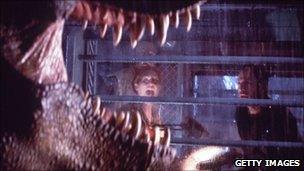Room in your lounge for a dinosaur skeleton?
- Published

The Allosaurus is an older, smaller cousin of the Tyrannosaurus Rex
Giant carnivorous dinosaur skeletons rarely go on sale, so this week is a particularly exciting one for avid fossil collectors, with the auctioning in Paris of an Allosaurus skeleton.
The Sothebys sale is the second large auction of fossils in less than six months, after Bonhams sold more than 400 dinosaur items in New York in May.
The Allosaurus - an older, smaller cousin of the Tyrannosaurus Rex - walked the earth 155 to 145 million years ago, and weighed up to three tonnes.
Found in Wyoming in the US, the 33-ft long skeleton is the most complete of its species, with 70% of its bones.
The massive fossil is estimated to sell for around 800,000 euros ($1.1m) - and it could go into a private collection. But who would buy a dinosaur with such a whopping price tag?
'Flashy fossils'
Eric Mickeler, a natural history specialist at Sotheby's, told Reuters that "in the last few years, you've had modern art collectors who think this kind of item can find its place in an interior with modern art".
The auctioneers hope the Allosaurus will follow in the footsteps of its most famous fossil, Sue - a Tyrannosaurus Rex - which was sold to a Chicago museum for a record price of $8.3 million (£5.2m) in 1997.
The Allosaurus has yet to be christened, with the honour of naming it being reserved for the highest bidder, according to Sothebys.
But is it acceptable for someone to hoard scientific objects in their lounge?
David Martill, a palaeobiologist at Portsmouth University, says the buyer could be "anyone who has a lot of money and a whim to have a dinosaur in their front room".
"But you have to have a house that is big enough," he adds.
The buying of fossils has become increasingly popular, he says, and prices have "gone up phenomenally".
"People think they are good investments, apart from the rich dinosaur nerds. It became sexy after Jurassic Park [the film] came out."
Even in times of a global recession, prices have increased and the skull of a Triceratops which cost $25,000 (£16,000) a decade ago might now cost you ten times as much, according to the Wall Street Journal.
But are they a secure investment?
"I've heard they are not, because they are not like art - they might be unique when you buy them but then more are found, and they devalue yours," says Darren Naish, a palaeontologist and writer.
"Within the last 20 years there have been more flashy fossils bought. Many by big corporations, that want them for lobbies, for conference centres," he adds.
And it is not just corporations who are in the market.
In 2007, famous actors Leonardo DiCaprio and Nicolas Cage made the news after reportedly fighting over the skull of a tyrannosaurus bataar at an auction; the skull was finally won by Cage for $276,000 (£174,000).
And Dr Martill says many people from across the world buy fossils for private museums or collections.
One Japanese dealer called him up looking for a Sauropod, he says, for which he was offering £500,000 ($790,000).
'Limitless money'
In some cases, according to Dr Martill, it is just "people who have more money than they know what to do with".
"It's an ego-trip. Oh look at me, I have an Allosaurus."
He says he believes the Sothebys sale will be popular because "big sexy dinosaurs like the Allosaurus don't come up that often".

Films such as Jurassic Park may have increased interest in fossil collecting
But the commercial sale of fossils is controversial, with many in the field arguing that it could prevent artefacts being used for science or education.
"I see so many things being lost to commercial dealers, who sell them on to rich buyers," says Dr Naish.
"We have so much trouble finding money for research of any kind. But then there seems to be people with limitless money to buy for their private collection.
"They are used as if they are expensive pieces of art," he says.
He said he believed there was a trend in buying "sexy" dinosaurs, on artistic merit or for "kudos", and a tendency for auctioneers to sell the ones that would attract the most public interest.
"Are they bought because they have a neat or cool factor - because people won't be interested in boring little plant-eaters?"
There are some like Sue who have what he calls happy endings, and end up in a museum - but that required the collaborative financial efforts of Californian State Museum, Walt Disney and McDonald's, to out-compete other buyers.
He argues that other, perhaps less fashionable fossils, just get sold on to individuals and are "gone".
'God-given right'
Prof Kevin Padian, a palaeontologist and curator from the University of California in Berkeley, says the "problem is that it robs us of our patrimony".
"Not every specimen is priceless in scientific or educational terms, but who should make this decision - auctioneers?"
In general, he says: "There's no guarantee that the skeleton you're buying is correctly identified, you don't know what has been restored or reconstructed (often from very different animals).
"So they are not good investments, except in the minds of other people who want to impress their friends."
But Dr Martill disagrees, saying he does not believe scientists have "some God-given right" to fossils.
People like him, he says, do not have time to go out and find fossils, but the market means there is an incentive for anybody to search for new samples.
"If we didn't have a commercial market, most fossils wouldn't come out of the ground."
- Published23 September 2010
- Published26 May 2010
- Published8 September 2010
- Published23 August 2010